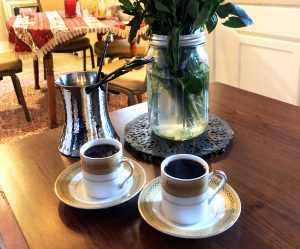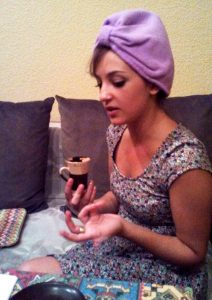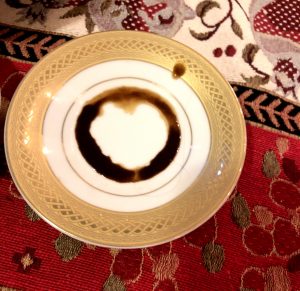Coffee’s Sixth Sense 🔮
A History of Fortune Telling and Family Tradition
By Michelle Abbey, Zingerman’s Coffee Company
The year is 1974. The setting is one startlingly bygone, culturally: a family living room, thick with cigarette smoke. Zingerman’s Coffee Company’s Managing Partner, Steve Mangigian, is 10 years old. After a meal together, Armenian coffee is not only served, but read. Steve recalls the female elders of his family flipping the contents of their cups onto saucers, scouring the grounds for images and their associated fortunes to emerge.
This is the story Steve consistently tells on his tours, during our “What is your first memory of coffee?” group icebreaker. “My parents needed a pot of Folgers to wake up.” is a common answer – I have yet to hear a guest share Steve’s experiences with family divination. He lights up; it’s a beloved childhood memory.
His experience while treasured is not unique. In fact, Steve isn’t the sole Armenian here in the small family of Zingerman’s Coffee Company! We’ve had a handful of Armenians come and go, and our Purchasing Manager, Laura, has Armenian roots.
“…She said it was extremely creepy and really hated the whole thing!”
The tradition in her family is remembered differently: “My mom talked about the tea leaf readings when she was a kid. This would have been the 1930’s. She remembers all the old Armenian ladies sitting in a circle bending over these cups and telling fortunes – they would tip them over into the saucers and read the leaves. She said it was extremely creepy and really hated the whole thing!”
The practice Steve and Laura describe in their families is called Tasseography: a divination or fortune-telling method that interprets patterns in tea leaves, coffee grounds, or wine sediments. The terms derive from the French word tasse (cup), which in turn derives from the Arabic loan-word into French tassa, and the Greek suffixes -graph (writing), -logy (study of), and -mancy (divination).
The practices’ origins can be traced back to medieval Europe. Fortune tellers read molten substances such as wax or lead. The method evolved into reading patterns of tea leaves after Dutch merchants introduced tea to Europe via trade routes to China. The tradition of coffee cup reading specifically is believed to have started in the 16th century when coffee made its way to the Ottoman Empire and the Middle East. The cultivation and distribution of coffee started in Ethiopia and moved from Yemen to the Arab trade and then to the Ottoman Empire. Armenians then popularized coffee in Europe.
Turkish coffee reading is very popular in Turkey and Greece. You can also find it in Russia and Eastern Europe, as well as Baltic and Middle Eastern countries.

A traditional Ibric (kettle) and Armenian coffee cups. Note how the sides of the coffee cup do not slope down – this is necessary for proper grounds reading.
This tradition has gone by the wayside for some families, but the Mangigians are keeping it alive in their brood. Steve’s daughter, Bethanie, has taken over the tradition – but took her own route to get there.
“I actually wasn’t introduced to Armenian fortune-telling within my family, I wasn’t around it a lot as a kid.
“‘…’I see three men in your cup, encircling you.’ It was dead on, I had three orbiting at that time!”
I started doing this when I lived in New York. I was in college and took a course in Armenian history. I was first captivated by cup reading sitting in an ancient Armenian library. My professor did my first reading for me, it was startling and thrilling. She said, ‘I see three men in your cup, encircling you.’ It was dead on, I had three orbiting at that time! Should we include that?” she laughs.
Bethanie studied and lived abroad in the familial homeland of Armenia, with a host family. She got practice pulling cups with them, a family of artists.
“In their home and in the country itself, I was surrounded by beautiful imagery and architecture. There were beautiful symbols everywhere to inspire interpretations.”
It’s not just the cultural connection and experiences which draws Bethanie to cup reading.
“My mom uses the word ‘Kezba’, to describe this sixth sense that we have. And I work closely with people as a social worker and therapist. When you read cups, you have a connection with that person. I love this medium as a way to develop relationships with people. You cut through small talk to who they are, what their journey is. I can guide the reading, but people come up with their own interpretations, which is fascinating insight.”
Her eeriest experience?
“I did a cup reading at a party for a guy I had met just a week prior. We ended up dating later on, and the symbols I saw in his reading ALL appeared throughout our relationship. A chameleon was one symbol – it ended up being way too telling! This is why I prefer to read for strangers. Reading for friends can hit too close to home. You have to be prepared for what the cup says.”

Bethanie hosts an Armenian Christmas party every year on January 6th, at her home in New Orleans. Her party favor giveaway is a drawing for someone to get a cup reading.
How do you read coffee, anyway? Simply drink your Armenian-style coffee in white china with no inside pattern or decoration. Shapes and patterns inside the coffee cup and on the saucer need to be visible for reading. After drinking most of the liquid in the coffee, cover the cup with the upside-down saucer and swirl three times. You wait for the grounds to fall from the bottom of the cup. This is why it is important to use the Armenian style espresso cup which is not rounded on the sides. The grounds fall down the sides of the espresso cup and dry at the bottom.
Put it down and allow a few minutes for the coffee to settle. Though it has some universally agreed rules, coffee cup reading is a very personal experience based upon on the “sixth sense”.
The type of coffee you use doesn’t really matter, just make sure it’s ground even finer than espresso and prepared, well, however your grandmother taught you to!
STEVE’S RECIPE:
- 8g coffee (Grind setting: 1 – finer than espresso, should feel like powder)
- 80g cold water
- 6g sugar
- 1 pinch of fresh ground cardamom OR
- 1 drop of rosewater
DIRECTIONS:
- Combine ingredients
- Bring to a boil and immediately
- Remove from heat
- Pour slowly to minimize the quantity of grounds in cup
Bethanie says this practice feels more precious in these times. “There’s a war against this small country [Armenia]. Holding onto these traditions feels even more important now. There are a lot of people I’m thinking about and worried about there right now.
“You may lose territory, but you can hang onto your culture.”
She wishes she could have been at the table with her Dad when her great aunt was telling fortunes. “It goes to show that these things need to be explicitly passed on, or you may lose them. You may lose territory, but you can hang onto your culture.”
Check out tasseography symbolism and best practices:
- https://coffeecupreadingsonline.com/divine-meanings-of-coffee-shapes/
- http://www.turkishstylegroundcoffee.com/turkish-coffee-reading/
—-
SOURCES:
- https://en.wikipedia.org/wiki/Tasseography
- https://coffeecupreadingsonline.com/divine-meanings-of-coffee-shapes/
- http://asbarez.com/174421/the-art-of-coffee-cup-reading-lives-on-through-a-new-generation/
- http://folklore.usc.edu/armenian-coffee-readings-ritual/
- http://www.digitaljournal.com/blog/16194
- http://elegantserenity.com/tasseography-art-tea-leaf-reading-future/
- http://www.turkishstylegroundcoffee.com/turkish-coffee-reading/


